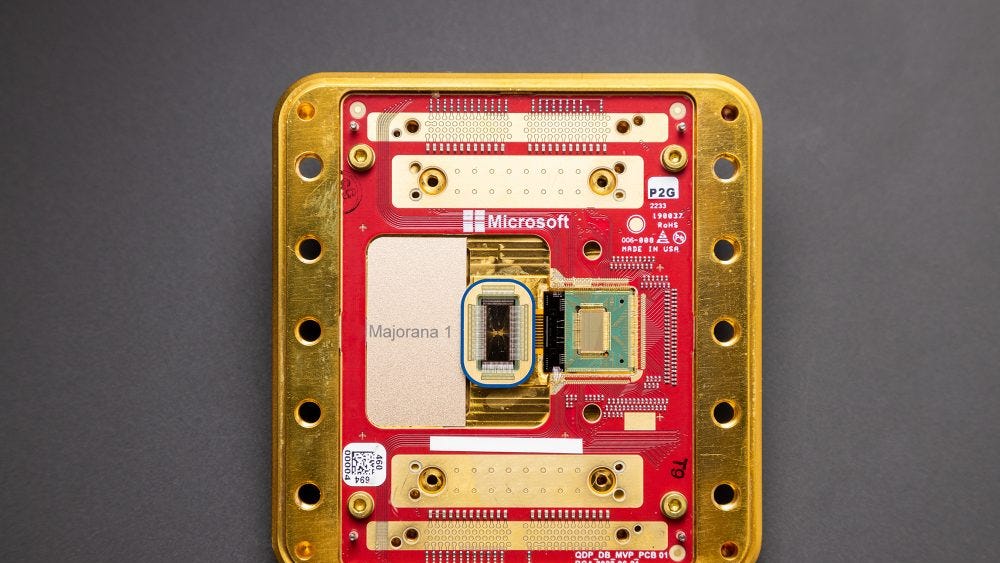“Hearst Magazines and Yahoo may earn commission or revenue on some items through these links.”
-
The biggest limitation of quantum computers is that they only contain, at max, around 1,000 qubits due to disruptions caused by noise that leads to decoherence.
-
Microsoft set out years ago to develop a topological qubit using Majorana quasiparticles—small and inherently stable, they make perfect candidates for quantum computers.
-
This week, Microsoft announced that it had created a new quantum architecture called Majorana 1, which it believes is the first step toward building a quantum computer with 1 million topological qubits—though, some physicists remain skeptical.
Quantum computers—like nuclear fusion and other hyper-advanced technologies—always seem to be just on the threshold of changing the world. And, like fusion, quantum computers have a problem with stability. While fusion experts are working on ways to stabilize the ultra-hot plasma required to sustain their reactions, so too are quantum engineers looking for ways to stabilize qubits in order to reduce errors and (hopefully) create machines that exceed today’s current threshold of around 1,000 qubits.
This week, Microsoft announced that it had made a major breakthrough in achieving that goal, stating that they created a quantum architecture—known as Majorana 1—that’s capable of one day hosting one million qubits on a single chip. To achieve this technological breakthrough, the company decided years ago to, in a sense, go back to the basics. Instead of using qubits found in other quantum computers, Microsoft engineers set out to create what’s known as a “topological qubit”—a different approach to creating a qubit that theoretically should make them more stable, and therefore scalable.
To do this, Microsoft uses what’s known as a Majorana quasiparticle. True to their name, Majoranas aren’t really particles, but are instead special patterns that arise under certain conditions. This new architecture—which Microsoft calls the Topological Core powered by “topoconductors”—can coax into existence (using nanowires, superconductors, and lots of fancy physics) a Majorana zero mode state that’s inherently stable. It’s also small, which is a big deal if you want to keep quantum computers from reaching warehouse-level dimensions. A new paper published in the journal Nature showed that they could measure the two different states within a qubit.
“We’ve designed a chip that’s able to measure the presence of Majorana, and Majorana allows us to create a topological qubit,” Microsoft technical fellow Krysta Svore detailed in a video about Majorana 1. “A topological qubit is reliable, small, and controllable. This solves the noise problem that creates errors in qubits.”
Currently, Majorana 1 holds only eight of these qubits, which isn’t nearly enough to perform world-changing calculations. But Microsoft argues that the architecture is in place to eventually scale the number of topological qubits up to one million—a feat that, if true, would surely usher in the age of quantum computing.
However, some scientists remain skeptical of Microsoft’s claims. For one, a paper hasn’t yet been published about its topological qubit claims for peers in the field to analyze. And secondly, many impurities can create conditions that look like Majorana quasiparticles, but are not. “The optimism is definitely there,” Henry Legg from th University of St Andrews told MIT Technology Review, “but the science isn’t there.” It also doesn’t help that a Microsoft research team in Delft, Netherlands announced that it had created Majorana states in 2018, only to retract the paper three years later due to erroneously omitted data.
However, Microsoft technical fellow Chetan Nayak remains bullish on their breakthrough, telling The New York Times that the quantum computing era could begin “as something that is years away, not decades away.”
With the introduction of Majorana 1 and the resulting Nature paper, the team has definitely demonstrated that they have a qubit. Now, they need to prove its topological nature and start making some computations. If Microsoft can prove that its Topological Core is the real deal, then we very well may be on the path to one million qubits and a computational revolution.
You Might Also Like
